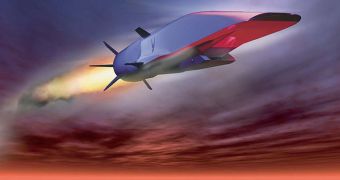A consortium of government and private organizations and agencies in the United States is gearing up for the second test flight of an aircraft that utilizes a new type of engine. Scramjets have been proposed for years, but actually building one proved to be a lot more difficult than engineers thought.
This technology holds great promise for the future, experts say. It could enable faster air transport, as well as underlie a shift in our current paradigm of how to get to Earth's orbit. Cumbersome rockets fueled by chemicals could become a thing of the past.
A spacecraft outfitted with a scramjet could make its way to orbit without the need to carry an external fuel tank or any extra booster rockets. Such a setup is currently used on the American space shuttles, primarily because they are very heavy.
But, before these engines can be outfitted on aircraft and spacecraft alike, experts need to tests them rigorously. This is precisely what is about to happen with the X-51A Waverider hypersonic scramjet.
The project is being developed by the US Air Force (USAF), NASA, Boeing, Pratt & Whitney Rocketdyne and the US Defense Advanced Research Projects Agency (DARPA). The X-51 prototype is scheduled to fly at hypersonic speeds.
According to USAF officials, the second test flight ever of the X-51 will take place today, March 23. The maneuvers will be conducted at the Edwards Air Force Base (EAFB), in California.
A B-52 heavy bomber will carry the Waverider to an altitude of 50,000 feet (15,240 meters) above the Pacific Ocean, and will then release the aircraft to fly on its own. At first, it will use a booster rocket to accelerate to about Mach 4.5.
Once this speed is reached, the scramjet will go online, and will accelerate the X-51 even further. During these new tests, officials from the consortium want to achieve Mach 6 or more.
The first flight of the X-51 took place in May 2010, and the aircraft set a duration record of 200 seconds of autonomous flight at Mach 5. However, the flight was supposed to last for 300 seconds, and reach Mach 6.
What the new aircraft does is to basically tie atmospheric and space propulsion together, and make them accessible to a single engine. Scramjet engines have a fairly simple propulsion system, but which is extremely difficult to create in practice.
Aircrafts employing them are generally designed in such a manner that they are able to make their own shock waves go directly into their engine's inlets. In other words, they no longer actively absorb air into the combustion chamber, but rather “model” it in through their shape.
This allows scramjet aircraft to reach speeds of up to Mach 15, and to go as high as the edge of space, Universe Today reports.

 14 DAY TRIAL //
14 DAY TRIAL //